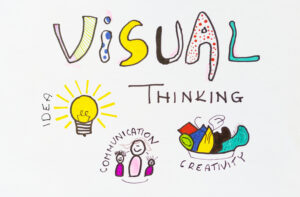Customers buy with their eyes, it’s easier to buy when in a picture – you might be familiar with these sayings. Both relate to the power of an image.
Those who created them understood it was simpler and quicker to interpret a message made not just of words and phrases, but also of pictures, symbols, and colors. Not just that, pictures are what remains in our memory. The power of an image was the basis for forming a technique known as visual thinking, available in various parts of our lives. How do you harness this power in your company or why it is worth it – read below.
Visual thinking, or… put it down on paper
Visual thinking is, as the name implies, thinking with visuals. More precisely, utilizing visual means of conveying information based on handwriting, drawings, hand-drawn typography, shapes, and other simple visual elements.[1] The stage of visualization starts during the thinking process. The next step is to convert the image into a piece of paper or other media, like a touchscreen of a tablet or laptop.
Traditional thinking enriched with images is common in various parts of our lives, including business. Companies, regardless of their industry, like to apply visual thinking in fields like meetings, brainstorm sessions, process management, workshops, presentations, or conferences. More importantly, visual thinking is no longer regarded as something exclusive to employees of creative departments. This is the right way to go because it gives every employee a chance to become open to new possibilities, free their mind, and create a clear and simple message on every career level.
How do visual thinking help you and your company?
Those who learned about visual thinking point out how remarkably effective visual forms of organizing and conveying thoughts are in business. This is especially evident in the context of team communication, forming long-term strategies, and product presentation for prospects. Why is it important to delve deeper into the subject?
Learn the 5 greatest business benefits of visual thinking for you and your company:
1. It gives you a different perspective
It is said that everything is a matter of perspective. Admittedly, a perspective can be narrow and limited, but the good news is, this does not have to be the case. Visual thinking allows us to open up to new ideas, to expand or even alter our viewpoint and to show us new possibilities that we might have not suspected ourselves of.
2. It organizes your thoughts
Thinking with images is how we can put our thoughts in order. We learn to handpick freshly developing ideas, so it’s easier to express our visual concepts to others. When making visual notes or pictures, we are prone to ask ourselves:
- What am I seeing?
- How am I seeing this?
- What do I want to convey?
- How much is there?
- What am I not seeing?
- How do I visualize this?
- What is missing?
- Is this clear to me?
It’s great to start with ourselves, because once we’ll learn the answers to these questions, our audience will comprehend them as well.
3. It stimulates creativity
By thinking visually, we work up our imagination and develop cognitive curiosity. Images drive our brains to think creatively. As our senses heighten, something new, often exceptional and original, comes to life. We become visual pioneers. Being a talented cartoonist is not required as it’s less about artistic skill and more about a clear message. Sometimes all you need is one symbol, one icon, or one diagram, to change the course of the whole process.
4. It improves communication
By setting clear objectives, allocating and accounting tasks, and motivating you and others to keep on working. The right visual notes carry great communication value for both the team and the whole company. Not only do they help persuade clients, but also make it easier for us to spot gaps or shortcomings hidden in the process. Thanks to them, we see more, better, deeper, and are more likely to share our insights with others. Visual thinking makes it far easier to express more complex ideas. This is invaluable support at virtually every stage of the design process.
5. It gives free means of expression
When we head out to work, we usually “leave” our emotions at home, seeing them as unfit for the workplace and something negative in general. Meanwhile, emotions can also mean something good and exciting. They are natural and instinctual, serving special purposes: to inform, mobilize, affect well-being. A whole set of readily available responses, released and benevolently utilized thanks to visual thinking. One might argue it is a form of active relaxation that is beneficial for both focus and attention. Now that we know the positive effects of visual thinking, we can put it into practice!

How to start?
Firstly, what we need is a pen/pencil and a sheet of paper. With these tools in hand, we can start “pouring” our thoughts on paper. Use arrows, lines, simple or more complex shapes, icons, symbols, diagrams – anything to help you describe what you think. Add a caption, description, list of numbers. Merge the text with the image. How about some color? What can we get out of this?
- Outline of the product/service
- Note from a meeting
- Cooperation project
- Product development project
- Presentation for a client or boss
- Website mockup template
- Infographics
- Brief
- Webinar summary
- Marketing strategy
- Materials for clients/partners
The most important thing is to let go and get rid of thoughts like, “I can’t draw”, “I have no talent.” Remember that activities of a creative nature, like visual thinking, stir our imagination, have a positive effect on self-development and are a healthy coping mechanism against negative emotions.
Good luck drawing your thoughts out! 🙂
[1] Tolman, K. (2018). Sketchnoting – co to jest?



